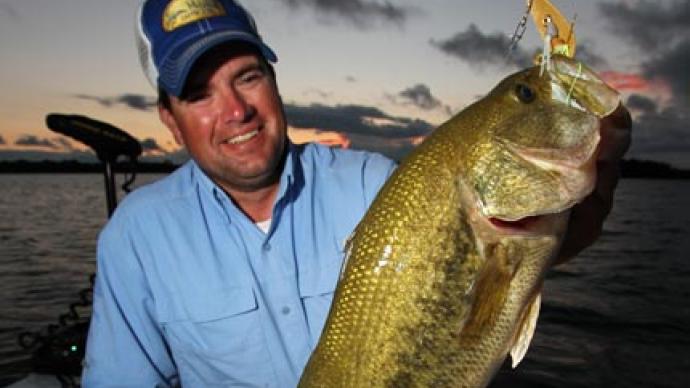Swimming spoons are perhaps the most weedless of all lures, and should be fished where no other lure will go: in the thickest, sloppiest cover you can find. They're ideal for surface weeds as well as subsurface mosses such as hydrilla, emergent and subsurface grass, hyacinths, and other floating cover.
Swimming spoons should be fished on heavy baitcasting gear with heavy line because of where you fish them. A 7-foot rod is ideal for these baits as it gives you added leverage to coax a big bass out of heavy weeds and lets you keep your line off the weeds to prevent tangling. Naturally, a heavier spoon is required when you use heavier tackle, and a fast-sinking bait may not prove effective. Therefore, the trailer should balance the spoon's weight to give it sufficient casting distance without sinking too quickly.
Try These Retrieves
| Crankbait: | In submerged grass, simply reel in the lure steadily as you would a crankbait. The bait will wobble and dart erratically, and the trailer will dance and flutter. |
| Stop & go: | In surface weeds, cast the bait, allow it to sit on the pads or matted grass, and skitter it along for a foot or so. Then stop. Allow it to rest and repeat. In lily pads, skitter the bait across the spaces and holes between the pads. |
| Tumbling: | In lily pads, let the lure cross the top of the pads, then slowly draw it over the edge by pulling gently with your rod. Then allow it to tumble down. |
| Crawling: | Slowly crawl the spoon over the top of the thick pads or moss cover with the rod held high. |
Trailers
Three main types of trailers commonly used on swimming spoons: pork rind, skirts, and soft plastics. A large pork frog can be used over the weedless hook. Often fishermen trim some of the meat off the pork with a sharp knife to provide an increased fluttering action. Split-tailed plastic trailers are especially effective on swimming spoons. A bright, contrasting color such as a red trailer on a chrome spoon is often the key to provoking moody bass.
Tips
- Always allow the bass to take the spoon completely beneath the surface before setting the hook. Immediate hook sets often result in pulling the spoon away from the fish.
- If a big fish strikes the spoon, it is often a better idea to go to the fish instead of applying a great deal of pressure to reel it in and risking breaking the line or tearing out the hook. The fish often buries in dense cover or pad stems and swims free once you move closer.
- A push pole and a rake are handy items to bring along in your boat when fishing dense weed beds with swimming spoons. The push pole will help you maneuver your boat where a trolling motor might get bogged down with weeds. The rake can help you clear a path to little-fished areas and make holes in the weeds that draw baitfish and bass.
- When fishing in the weeds with these baits. Pay attention to nature's signals. Popping bream often indicate overall feeding activity. A swirl in the pads might signal a feeding bass.
- When fishing rocky ledges (i.e., old coal strip pits), let a spoon fall from the bank or a ledge. This simulates baitfish driven to the shore that are jumping to escape. Let the lure fall for about 2-4 seconds, then use a medium retrieve to catch a monster!
- If you use the spoon "Red Devil" cast out, let it sink. Reel it in 5 cranks, then let it set. Then reel it in in a slow-moving motion. I have used this method and caught many Bass. This method works better than any other with a "Red Devil."
- I always take at least one jig of each size and replace the hook with a 1/0 Kahle hook. That way, I can rig a worm or grub to it weedless. In addition, it adds weight, flash to the soft plastic, and color to the spoon.




